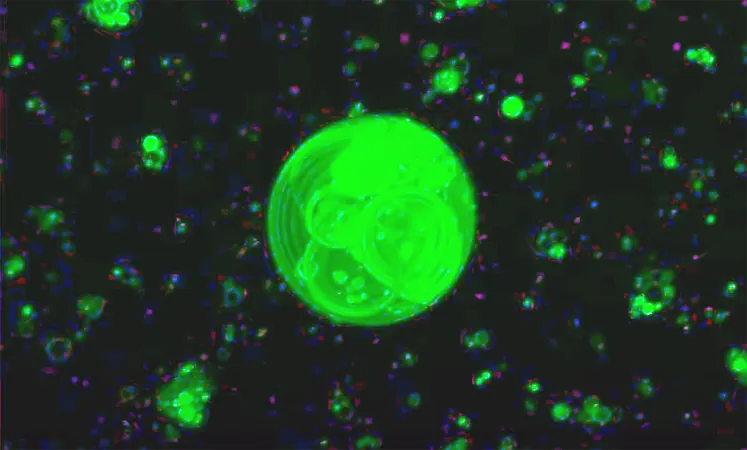
Revolutionary B Cell Discovery Paves the Way for Advanced Vaccine Design!
2025-03-31
Author: Jia
Recent cutting-edge research has uncovered the intricate mechanics of B cells and their unique ability to balance mutation and clonal expansion to enhance antibody efficacy.
This groundbreaking discovery could transform vaccine development, enabling the creation of more focused and potent vaccines for a wide range of diseases.
The effectiveness of vaccines in producing long-lasting, high-affinity antibodies hinges on a delicate interplay within the immune system. Upon encountering a vaccine or pathogen, B cells engage in a high-stakes game of mutation, seeking to refine their antibodies to achieve optimal effectiveness. However, this process is fraught with risk, as while some mutations can improve antibody affinity, a vast majority result in degraded or ineffective antibodies. This raises an important question: how do high-affinity B cells consistently outsmart the odds?
Understanding the Risks of Evolution in Immunology
Vaccines and infections catalyze the formation of germinal centers, specialized immune structures where B cells experience rapid mutation and selection. This process, however, is inherently risky, as most mutations are random and harmful. According to classical evolutionary theories, it would seem that high-affinity B cell lineages should deteriorate over time, accumulating detrimental mutations.
Yet, empirical evidence remains at odds with this notion, as these germinal centers reliably produce remarkably effective antibodies. Researchers began to suspect that there exists an internal mechanism that allows high-affinity B cells to maintain their advantageous traits while deftly minimizing mutation risks.
The Innovation of B Cell Behavior
The study illustrates that high-affinity B cells employ a novel strategy: rather than engaging in relentless mutation, they can opt to enter a phase of clonal expansion, replicating themselves while reducing mutation risks. This revelation was made possible through the use of single-cell RNA sequencing, revealing that during this clonal expansion phase, high-affinity B cells proliferate at higher rates while mutating less frequently.
Further examination revealed enhanced support from T cells, which assists these B cells in transitioning through the cell cycle more rapidly, especially in bypassing the G0/G1 phase often associated with hypermutation. On the other hand, lower-affinity B cells remain entrenched in prolonged hypermutation cycles, attempting to generate superior antibodies through continuous variation.
Validation of these findings was achieved via immunization studies in mice, utilizing model antigens as well as the receptor-binding domain of the SARS-CoV-2 spike protein, bolstering the evidence for this strategic evolution in B cell behavior.
Implications for Future Vaccine Strategies
This discovery opens the door for innovative approaches to vaccine development tailored to specific pathogens. For complex diseases such as HIV, characterized by rapid viral evolution and protective glycan shields, vaccines could be designed to prolong the hypermutation phase before transitioning to clonal expansion. This optimization may significantly enhance the chances of producing broadly neutralizing antibodies.
Conversely, for diseases necessitating rapid establishment of stable, high-affinity antibodies—like influenza or coronaviruses—strategies may pivot towards encouraging an early transition to clonal expansion, securing prompt and effective immune responses.
Julia Merkenschlager, the study's first author and visiting assistant professor at Rockefeller University, emphasized, “Our work shows how high-affinity B cells can bank really advantageous mutations by essentially cloning themselves rather than continuing to mutate. Perhaps we will soon be able to tailor vaccines to tip the scales either toward mutation or cloning.
Looking ahead, researchers aim to validate these findings in human subjects and explore how vaccine adjuvants or other techniques may influence the mutation and clonal expansion balance. If successful, these efforts could revolutionize vaccine development, yielding more efficient and targeted immunization strategies.
Conclusion: A New Era in Vaccine Design
By manipulating the immune system’s balance between mutation and clonal expansion, scientists stand on the brink of a pivotal transformation in vaccine design. Understanding how B cells strategically "gamble" on mutations or "bank" advantageous changes paves the way for the development of vaccines tailored to combat specific pathogens effectively.
Whether it’s extending the hypermutation phase to tackle elusive targets like HIV or accelerating clonal expansion for swift protection against seasonal viruses, this illuminating research heralds a new chapter in precision immunology. As Merkenschlager states, “Now that we have a clearer vision of how to manage a cell's responses, we can start to conceptualize developing a more effective HIV vaccine.” Get ready for a breakthrough in vaccine technology!



 Brasil (PT)
Brasil (PT)
 Canada (EN)
Canada (EN)
 Chile (ES)
Chile (ES)
 Česko (CS)
Česko (CS)
 대한민국 (KO)
대한민국 (KO)
 España (ES)
España (ES)
 France (FR)
France (FR)
 Hong Kong (EN)
Hong Kong (EN)
 Italia (IT)
Italia (IT)
 日本 (JA)
日本 (JA)
 Magyarország (HU)
Magyarország (HU)
 Norge (NO)
Norge (NO)
 Polska (PL)
Polska (PL)
 Schweiz (DE)
Schweiz (DE)
 Singapore (EN)
Singapore (EN)
 Sverige (SV)
Sverige (SV)
 Suomi (FI)
Suomi (FI)
 Türkiye (TR)
Türkiye (TR)
 الإمارات العربية المتحدة (AR)
الإمارات العربية المتحدة (AR)